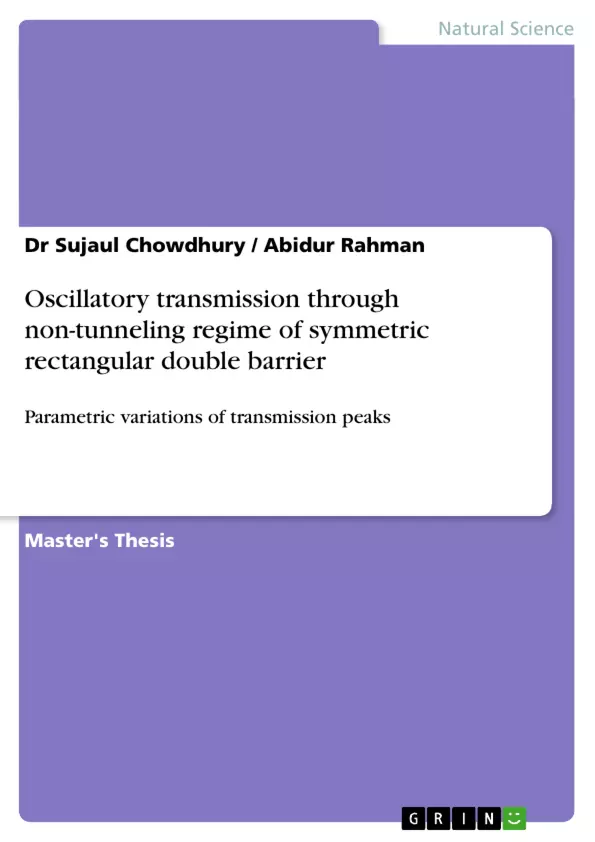We have numerically investigated parametric variations of transmission peaks of symmetric rectangular double barrier in non-tunneling regime. We have compared the variations with those for tunneling regime. One of the three variations in non-tunneling regime is completely different from that for tunneling regime warranting rapid dissemination. The book contains background on Quantum Mechanics, Microelectronics and Nanostructure Physics to enable readers assimilate the book completely.
Inhaltsverzeichnis (Table of Contents)
- Chapter I: Background on Quantum Mechanics
- 1.1 Wave equation of a free particle: Schrödinger equation
- 1.2 Schrödinger equation of a particle subject to a conservative mechanical force
- 1.3 Conservation of probability and probability current density
- 1.4 Time-independent Schrödinger equation and stationary state
- 1.5 Continuous and discontinuous function
- 1.6 Finite and infinite discontinuity
- 1.7 Admissibility conditions on wavefunction
- 1.8 Free particle: eigenfunctions and probability current density
- 1.9 Single rectangular tunnel barrier
- 1.9.1 Calculation of transfer matrix and investigation of its properties
- 1.9.2 Calculation of transmission coefficient
- Chapter II: Background on Microelectronics
- 2.1 Insulator and its band model
- 2.2 Intrinsic semiconductor and its band model
- 2.3 Elemental and compound semiconductors
- 2.4 Alloy semiconductors: ternary and quaternary semiconductors
- 2.5 Bandgap engineering
- 2.6 Substrate and epitaxial layer
- 2.7 Semiconductor heterostructure and heterojunction
- Chapter III: Background on Nanostructure Physics
- 3.1.1 Tunnel barrier: structure and band model
- 3.1.2 Transport of electron or hole through tunnel barrier
- 3.2 Quantum Well (QW)
- 3.3 Symmetric double barrier
- Chapter IV: Numerical investigation of parametric variations of transmission peaks of symmetric rectangular double barrier for non-tunneling regime
- 4.1 Transmission through symmetric rectangular double barrier
- 4.2 Description of the problem
- 4.3 Tables and Figures showing parametric variations of energy of transmission peaks of symmetric rectangular double barrier for non-tunneling regime
- 4.4 Conclusions about the parametric variations
Zielsetzung und Themenschwerpunkte (Objectives and Key Themes)
This work examines the transmission of electrons through a symmetric rectangular double barrier in the non-tunneling regime. The main objective is to investigate the parametric variations of the transmission peaks under different conditions. Key themes and objectives include:- Understanding the behavior of electrons in quantum systems, particularly in the context of double barrier structures.
- Analyzing the influence of various parameters, such as the barrier height, barrier width, and energy of the incident electron, on the transmission characteristics.
- Exploring the phenomenon of oscillatory transmission in the non-tunneling regime.
- Applying numerical methods to simulate and analyze the transmission process.
- Providing insights into the potential applications of these findings in the field of microelectronics and nanostructure physics.
Zusammenfassung der Kapitel (Chapter Summaries)
- Chapter I: Background on Quantum Mechanics: This chapter introduces fundamental concepts in quantum mechanics, including the Schrödinger equation, the wavefunction, and the principles of probability and current density. It also discusses the behavior of electrons in potential barriers, specifically addressing the single rectangular tunnel barrier.
- Chapter II: Background on Microelectronics: This chapter provides a background on the essential concepts of microelectronics, including band theory, semiconductor properties, and the fabrication of heterostructures. It lays the foundation for understanding the electronic behavior in the context of the double barrier system.
- Chapter III: Background on Nanostructure Physics: This chapter explores the physics of nanostructures, focusing on the characteristics of tunnel barriers, quantum wells, and symmetric double barriers. It provides the theoretical framework for the numerical investigations presented in the subsequent chapter.
- Chapter IV: Numerical investigation of parametric variations of transmission peaks of symmetric rectangular double barrier for non-tunneling regime: This chapter delves into the core of the research, presenting a numerical analysis of the transmission through a symmetric rectangular double barrier. It examines how the transmission peaks vary with different parameters, such as the barrier height and width, and discusses the observed oscillatory behavior in the non-tunneling regime.
Schlüsselwörter (Keywords)
The central focus of this work is the transmission of electrons through a symmetric rectangular double barrier in the non-tunneling regime. Key keywords and concepts include: quantum mechanics, Schrödinger equation, transmission coefficient, double barrier structure, nanostructure physics, microelectronics, bandgap engineering, numerical simulations, parametric variations, oscillatory transmission, and non-tunneling regime.
Excerpt out of 133 pages
- scroll top
- Quote paper
- Dr Sujaul Chowdhury (Author), Abidur Rahman (Author), 2013, Oscillatory transmission through non-tunneling regime of symmetric rectangular double barrier, Munich, GRIN Verlag, https://www.grin.com/document/230804
Look inside the ebook



